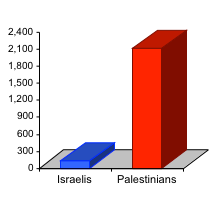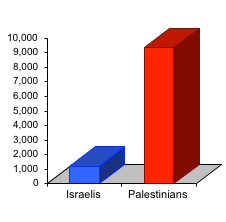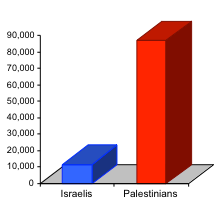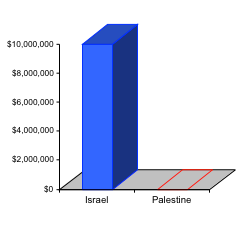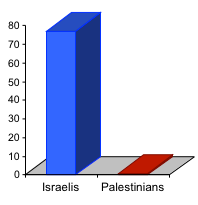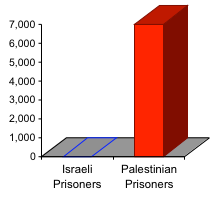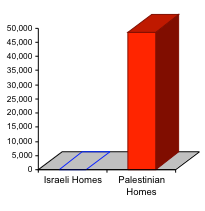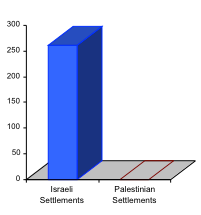| Online: | |
| Visits: | |
| Stories: |
Just to put things their proper perspective.
Just to put things their proper
perspective.
I used to be very pro-Israeli ….. stupidly pro-Israeli, until some situations jarred me out my blindness enough that I decided to do my own investigation into some things that began to pile up over a period of years. I needed to resolve some questions that wouldn’t go away. The deeper I dug for answers the more corrections had do be made to my flawed perspective. Now my perspective is about one hundred and forty five degrees from where it used to be. We don’t get much truth in this country anymore unless we make the time to search for it. Our normal data outlets are heavily filtered and sanitized of the real truth…..criminals can’t stand to have their behaviour exposed.
These graphs help to better understand the horrible imbalance that is the true reality between Israeli Jews and Israeli Palestinians. They are both citizens of the same nation state. The bigotry and descrimination manifested by the Israeli Jews is beyond criminal, it is closer to insanely wicked and this coming from a people who have supposedly been the victims of some horrendous treatment throughout history. You would normaly expect that there would be a higher level of compassion in these Jews considering what they’ve supposedly been through. Something is terribly wrong with this picture.
I am aware that there are many Jewish people who do have a great deal of compassion for their Palestinian brothers and sisters. Not all Jews are cold hearted monsters. My objective is to put the spot light on the cold hearted monsters that always manage to deflect scrutiny when it comes their way, no matter what race or religion they are. For this season of time the focus is on the Zionist because they seem to be pulling most (not all) of the strings.
http://www.ifamericansknew.org/
The Israeli-Palestinian conflict is one of the world’s major sources of instability. Americans are directly connected to this conflict, and increasingly imperiled by its devastation.
It is the goal of If Americans Knew to provide full and accurate information on this critical issue, and on our power – and duty – to bring a resolution.
Please click on any statistic for the source and more information.
Statistics last updated September 3, 2015
|
|
|
|
133 Israeli children have been killed by Palestinians and 2,061 Palestinian children have been killed by Israelis since September 29, 2000. (View Sources & More Information) |
|
|
|
|
|
|
1,198 Israelis and at least 9,139 Palestinians have been killed since September 29, 2000. (View Sources & More Information) |
|
|
|
|
11,446 Israelis and 73,158 Palestinians have been injured since September 29, 2000. (View Sources & More Information.) |
|
|
|
|
|
|
During Fiscal Year 2014, the U.S. is providing Israel with at least $10.2 million per day in military aid and $0 in military aid to the Palestinians. (View Sources & More Information) |
|
|
|
|
Israel has been targeted by at least 77 UN resolutions and the Palestinians have been targeted by 1. (View Sources & More Information) |
|
|
|
|
|
|
0 Israelis are being held prisoner by Palestinians, while 5,700 Palestinians are currently imprisoned by Israel. (View Sources & More Information) |
|
|
|
|
0 Israeli homes have been demolished by Palestinians and at least 28,000 Palestinian homes have been demolished by Israel since 1967. (View Sources & More Information) |
|
|
|
|
|
|
The Israeli unemployment rate is 6%, while the Palestinian unemployment in the West Bank is 16% and 45% in Gaza. (View Sources & More Information) |
|
|
|
|
Israel currently has 261 Jewish-only settlements and ‘outposts’ built on confiscated Palestinian land. Palestinians do not have any settlements on Israeli land. (View Sources & More Information) |
|
Fair Use Notice
This article may contain copyrighted material the use of which has not always been specifically authorized by the copyright owner. We are making such material available in our efforts to advance the understanding of humanity’s problems and hopefully to help find solutions for those problems.
We believe this constitutes a ‘fair use’ of any such copyrighted material as provided for in section 107 of the US Copyright Law. In accordance with Title 17 U.S.C. Section 107, the material on this site is distributed without profit to those who have expressed a prior interest in receiving the included information for research and educational purposes. A click on a hyperlink is a request for information.
Consistent with this notice you are welcome to make ‘fair use’ of anything you find on this web site. However, if you wish to use copyrighted material from this site for purposes of your own that go beyond ‘fair use’, you must obtain permission from the copyright owner.
Section 107. Limitations on exclusive rights: Fair Use not withstanding the provisions of sections 106 and 106A, the fair use of a copyrighted work, including such use by reproduction in copies or phonorecords or by any other means specified by that section, for purposes such as criticism, comment, news reporting, teaching (including multiple copies for classroom use), scholarship, or research, is not an infringement of copyright. In determining whether the use made of a work in any particular case is a fair use the factors to be considered shall include -
1. the purpose and character of the use, including whether such use is of a commercial nature or is for nonprofit educational purposes;
2. the nature of the copyrighted work;
3. the amount and substantiality of the portion used in relation to the copyrighted work as a whole; and
4. the effect of the use upon the potential market for or value of the copyrighted work.
Article 19 of the United Nations Declaration of Human Rights
ARTICLE 19. Everyone has the right to freedom of opinion and expression; this right includes freedom to hold opinions without interference and to seek, receive and impart information and ideas through any media and regardless of frontiers. (The Universal Declaration of Human Rights, adopted by the United Nations General Assembly on December 10, 1948)
“A cantankerous press, an obstinate press, an ubiquitous press, must be suffered by those in authority in order to preserve the even greater values of freedom of expression and the right of the people to know,” Judge Gurfein declared. “These are troubled times. There is no greater safety valve for discontent and cynicism about the affairs of government than freedom of expression in any form.” (Excerpt from a New York Times editorial of June 20, 1971, in The Pentagon Papers, 1971, p. 645)
You can read more about ‘fair use’ and US Copyright Law at the Legal Information Institute of Cornell Law School. This notice was modified from a similar notice at Common Dreams.





